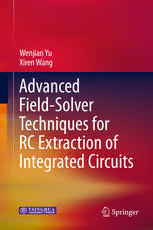Table Of ContentWenjian Yu
Xiren Wang
Advanced
Field-Solver
Techniques for
RC Extraction of
Integrated Circuits
Advanced Field-Solver Techniques for RC
Extraction of Integrated Circuits
Wenjian Yu • Xiren Wang
Advanced Field-Solver
Techniques for RC
Extraction of Integrated
Circuits
123
WenjianYu XirenWang
DepartmentofComputerScience CadenceDesignSystems
andTechnology SanJose,CA,USA
TsinghuaUniversity
Beijing,China
ISBN978-3-642-54297-8 ISBN978-3-642-54298-5(eBook)
DOI10.1007/978-3-642-54298-5
SpringerHeidelbergNewYorkDordrechtLondon
JointlypublishedwithTsinghuaUniversityPress,Beijing
ISBN:978-7-302-35151-1TsinghuaUniversityPress,Beijing
LibraryofCongressControlNumber:2014937680
©TsinghuaUniversityPress,BeijingandSpringer-VerlagBerlinHeidelberg2014
Thisworkissubjecttocopyright.AllrightsarereservedbythePublishers,whetherthewholeorpartof
thematerialisconcerned,specificallytherightsoftranslation,reprinting,reuseofillustrations,recitation,
broadcasting,reproductiononmicrofilmsorinanyotherphysicalway,andtransmissionorinformation
storageandretrieval,electronicadaptation,computersoftware,orbysimilarordissimilarmethodology
nowknownorhereafterdeveloped.Exemptedfromthislegalreservationarebriefexcerptsinconnection
with reviews or scholarly analysis or material supplied specifically for the purpose of being entered
and executed on a computer system, for exclusive use by the purchaser of the work. Duplication of
this publication or parts thereof is permitted only under the provisions of the Copyright Law of the
Publishers’locations,initscurrentversion,andpermissionforusemustalwaysbeobtainedfromSpringer.
PermissionsforusemaybeobtainedthroughRightsLinkattheCopyrightClearanceCenter.Violations
areliabletoprosecutionundertherespectiveCopyrightLaw.
Theuseofgeneraldescriptivenames,registerednames,trademarks,servicemarks,etc.inthispublication
doesnotimply,evenintheabsenceofaspecificstatement,thatsuchnamesareexemptfromtherelevant
protectivelawsandregulationsandthereforefreeforgeneraluse.
While the advice and information in this book are believed to be true and accurate at the date of
publication, neither the authors northe editors northe publishers can accept anylegal responsibility
foranyerrorsoromissionsthatmaybemade.Thepublishersmakenowarranty,expressorimplied,with
respecttothematerialcontainedherein.
Printedonacid-freepaper
SpringerispartofSpringerScience+BusinessMedia(www.springer.com)
Foreword
Thisbookisaboutthree-dimensionalRCextractiontechniquesformicroelectronic
designs.TheauthorsarefromtheParasiticParameterExtractionGroup,Department
of Computer Science and Technology, Tsinghua University, which has made
many significant contributions to the field since 1991. Some of their approaches,
e.g., direct boundary element method (BEM) for C extraction (2001–2006) and
hierarchicalblockBEM(2004),havebeenincorporatedinindustrialtools.
Resistance and capacitance (RC) extraction is an essential step to model the
interconnectwiresandsubstratecouplinginintegratedcircuits.Theparasiticplays
asignificantroleinthesystemperformance.Advancesoffabricationprocessesand
new materials with various dielectric permittivities call for accurate and efficient
extraction tools to handle complex geometries. Although RC extraction has been
aresearchtopicintheelectronicdesignautomationcommunityforabout25years,
largerdesignsandfasterprojectturnaroundhavekeptpushingthedemandforbetter
extractiontools.
Theauthorscoverthestate-of-the-arttechniquesofRCfieldsolvers,mainlythe
boundaryelementmethod(directorindirect)withacceleratingtechniquesandthe
fast floatingrandomwalk methods.These subjectsare relativelynew andof large
impacttheoreticallyandpractically.Thecontentalsoreflectstheresearchactivities
oftheauthorsinthelast10years.
Thisbookpresentsasystematicintroductiontoandtreatmentofthekeyconcepts
oftheextraction.Tothebestofmyknowledge,itisthefirsttimeforamonograph
dedicatedtotheadvancedRCextractiontechniques.Variousfield-solvertechniques
are explained in details, with examples to illustrate the advantages and disadvan-
tages of each algorithm. Readers are encouraged to consider the computational
complexity, physical theory, numerical stability, robustness of the algorithm for
general cases, and applicability for software development and maintenance. The
presentationbringsinsightsofsuitablesolversforspecificextractionproblems.
SanDiego,CA,USA Chung-KuanCheng
v
Preface
Themaingoalofwritingthisbookwastopresentamethodologicalandalgorithmic
perspectiveonthefield-solver-basedparasiticextractionofintegratedcircuits(ICs).
Specifically, we present advanced techniques based on three-dimensional (3-D)
boundary element method and floating random walk method for the problems of
resistanceandcapacitance(RC)calculation.Withthefeaturesizescalingdownand
mixed-signal interference in modern ICs, the research of parasitic extraction has
gained much concern in recent years and promoted the utilization of field-solver
methodsfortacklingthechallengeofaccuracy.
Now,thefieldsolverwhichdirectlysolvestheelectrostaticequationsisbecom-
ing more and more important for the RC extraction of ICs. It is a necessary
supplement, or even a replacer, of the existing parasitic extraction methodology.
On accurately capturing the complex interconnect geometry and the substrate
coupling in mixed-signalIC, the field-solver method has distinct advantages.The
major obstacle for its application is the excessive computational expense. The
complexity of interconnect structure and even tighter performance margin for
designingnanometer-technologyICshaveurgedtheextensiveusageoffieldsolvers.
Therandomprocessvariationsalsoaddsignificancetothisrequest.Allthesehave
pushed the related research for 20 years. Various accelerating approaches have
been proposed to reduce the computational expense while preserving accuracy.
Until recently, the achievementsof these works have been applied successfully in
industrialtools.Theyaredailyusedforsettlingthesign-offtimingandverification
issuesinvariousICdesigns.Theseachievementsinfield-solver-basedRCextraction
aretheobjectofthisbook.Wehopewehavesucceededinprovidingauniqueand
comprehensivetreatmentonthem.
Theworkspresentedinthisbookaremostlyfromresearchprojectsundertaken
by the Parasitic Extraction Group, Tsinghua University, China. Chapter 3 and
Chaps. 5, 6, and 7 are contributed by Xiren Wang, mostly from his Ph.D. work
at the Parasitic Extraction Group. The remaining chapters are written by Wenjian
Yu,basedonhisresearchwork.Manyofthoseoriginalpublicationscanbefoundat
http://learn.tsinghua.edu.cn:8080/2003990088/index.htm.
vii
viii Preface
We wanttoemphasizethatthebookisbynomeansintendedtobecomprehen-
sive.Theabsenceofcoverageofrelatedworksshouldbynomeansdiminishtheir
valueandcontribution.Manyacademicgroupsandexpertsfromindustryhavemade
significantcontributionsinthefield,andthereaderisencouragedtoinvestigatetheir
works. Key contributors to progress in RC field-solver techniques include: Jacob
White(MIT),WeipingShi(TAMU),LawrenceT.Pileggi(CMU),AliNiknejad(UC
Berkeley), Dan Jiao (Purdue Univ.), Vikram Jandhyala (Univ. Washington), Luca
Daniel(MIT),YannickL.LeCoz(RPI),SheldonX.-D.Tan(UCRiverside),LeiHe
(UCLA),RanjitGhapurey(UTAustin),CharlieChung-PingChen(NationalTaiwan
Univ.),Wayne Dai (UCSC), Nick van der Meijs (TU Delft), Luis Miguel Silveira
(TechnicalUniversityofLisbon),IbrahimElfadel(MasdarInstituteofScienceand
Technology),NasserMasoumi(Univ.Waterloo),MadhavP.Desai(IndianInstitute
ofTechnology,Bombay),AngeloBrambilla(PolitecnicodiMilano),AlkiviadesA.
Hatzopoulos(AristotleUniv.Thessaloniki),RubenSpecogna(Univ.Udine),Xuan
Zeng (Fudan Univ.), Zeyi Wang (Tsinghua Univ.), Wei Hong (Southeast Univ.),
JunfaMao(ShanghaiJiaotongUniv.),MartinBachtold(SwissFederalInstituteof
Technology), Sharad Kapur (Integrand Software Inc.), Joel R. Phillips (Cadence
Inc.),XiaoningQi(Intel),andZhuoxiangRen(MentorGraphicsInc.).
Beijing,China WenjianYu
SanJose,CA,USA XirenWang
Acknowledgment
ThecontentsofthisbookmainlycomefromtheresearchworksdoneintheParasitic
ExtractionGroupattheDepartmentofComputerScienceandTechnology,Tsinghua
University.
It is a pleasure to record our gratitude to many colleagues and students who
have contributed to this book. First of all, the authors would like to thank Prof.
ZeyiWangofTsinghuaUniversity.HewasthePh.D.thesisadvisorofbothauthors
and had been the leader of the Parasitic Extraction Group until 2006. The quasi-
multiple medium approach for accelerating the boundary element method (BEM)
originatesfromhisidea,andseveralworksonfastBEMapproacheswerealsounder
hisguidance.Manystudentsinthisgrouphaveexcellentcontributionstotheworks
inthisbook,includingDeyanLiu,MengshengZhang,LeiZhang,WangyangZhang,
Chao Hu, Qingqing Zhang, Hao Zhuang, Zhi Liu, Gang Hu, and Chao Zhang.
Special thanks are also given to Prof. Xianlong Hong of Tsinghua University for
his great support during these years and Dr. Jiangchun Gu and Dr. Jinsong Hou
graduatedfromthegroup,whohadprovidedasolidbasisforourresearchworks.
WenjianYuisgratefultoProf.ZhipingYuandProf.ZuochangYeattheInstitute
ofMicroelectronicsofTsinghuaUniversityandProf.ZuyingLuoofBeijingNormal
Universityformuchhelpfultechnicaldiscussion.ThanksarealsogiventoDr.Jinjun
Xiong of IBM Watson Research Center and Dr. Rong Jiang of Cadence Inc. for
theirinsightsfromindustry,whichinspiredtheworkonvariation-awareextraction
inthisbook.WenjianYuwouldalsoliketothankProf.Chung-KuanChengatthe
UniversityofCaliforniaatSanDiegoandProf.SheldonX.-D.TanattheUniversity
ofCaliforniaatRiversidefortheirhelpandencouragementofwritingsuchabook.
XirenWangisappreciativetothemembersintheParasiticExtractionGroupof
TsinghuaUniversity,wherehehadstayedfor5yearsandgotthePh.D.degree.Heis
also gratefulto Prof. VikramJandhyalaat the Universityof Washington,who had
been his postdocadvisor. Discussion with Dr. Dipanjan Gopeat the Universityof
Washington,andnowIndianInstituteofScience,waslargelybeneficialandreally
appreciated.
The authors would like to thank the National Natural Science Foundation of
China and the Beijing Natural Science Foundation for their financial support for
ix

